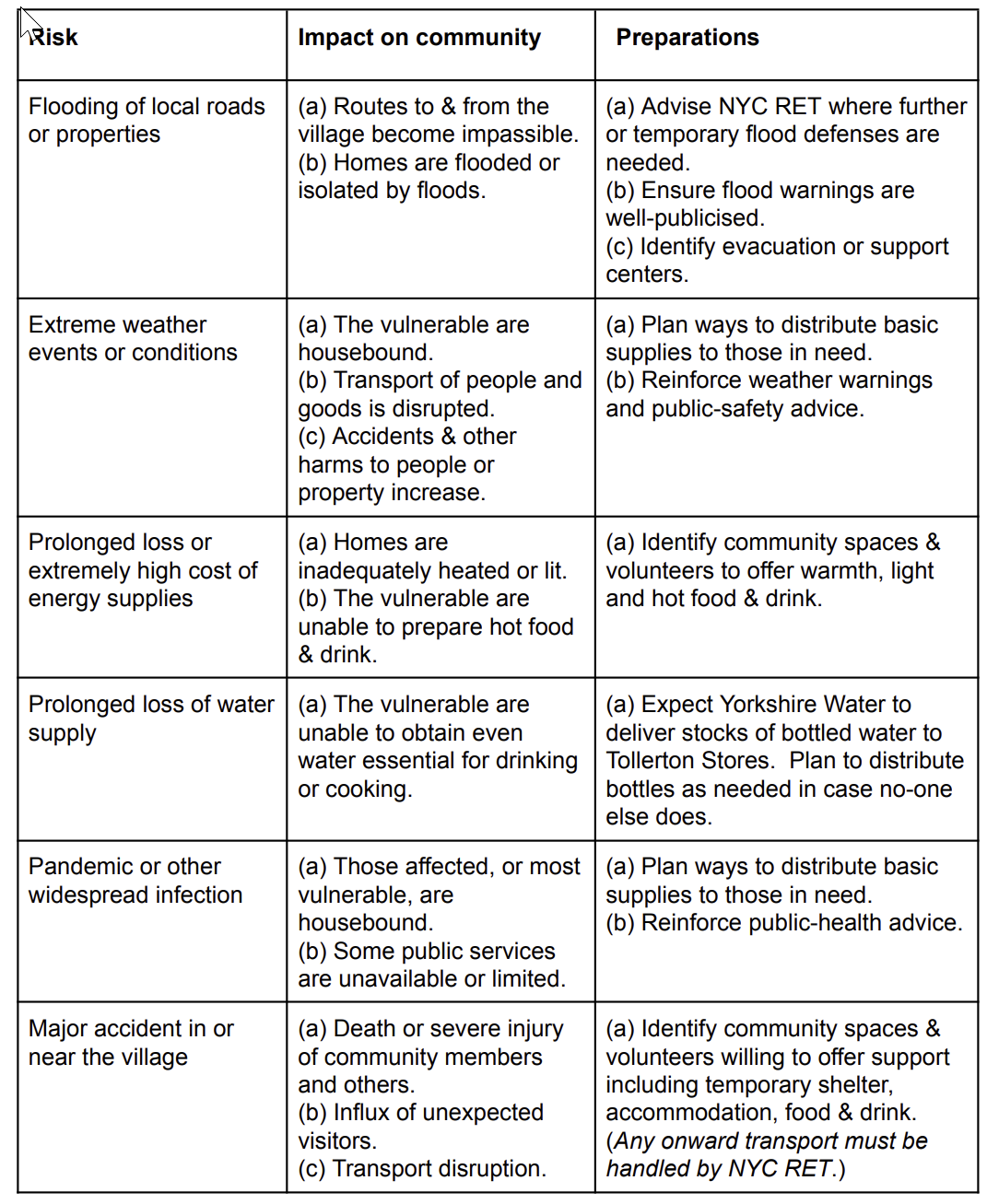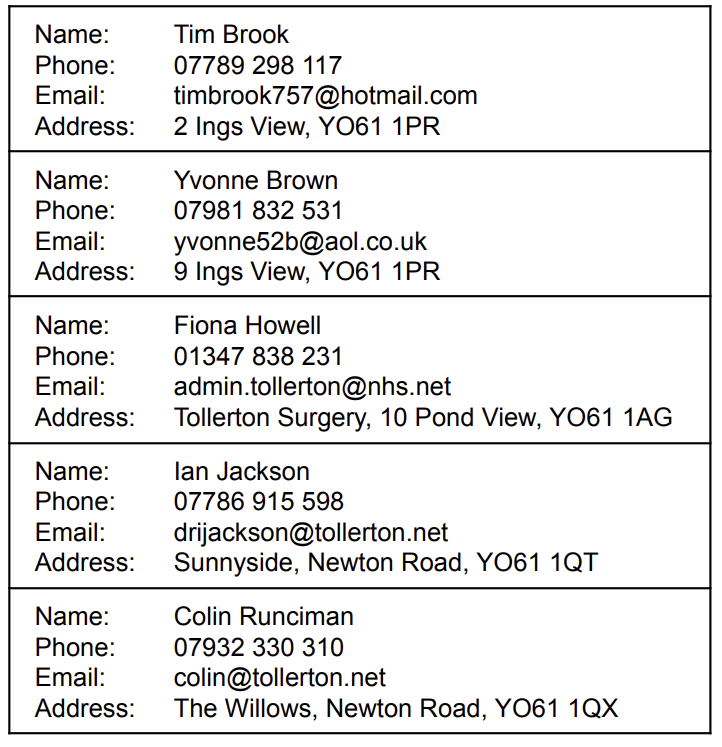Why have such a plan, when there are emergency services available? Communities that prepare for emergencies cope better in emergency situations. Though the response of emergency services is important, they must give priority to the greatest needs, and they cannot do everything. Communities can lessen the impact of an emergency by deploying their own resources to assist and complement the work of emergency services. This plan is intended as a concise source of information and guidance for the Tollerton village community. In particular it informs the work of a Community Emergency Group. What sorts of emergencies may arise, and how can we prepare for them? In the event of an emergency, how can we best respond? What resources are available locally? What can we do to support the work of emergency services? What steps can we sensibly take in circumstances where emergency services are unobtainable, or unable to help? The plan also provides key information for NYC’s Resilience & Emergencies Team (RET), and for those deployed by them who may not be familiar with Tollerton. Emergencies come in many forms, including the unexpected, so the following table cannot be exhaustive. However, bearing in mind the local environment, and the experience of recent years, here are some of the main risks, likely impacts and appropriate preparations for an emergency affecting the village. These are the two places in the village with sufficient space and basic amenities to provide a temporary refuge for large groups of people. They are registered with NYC RET. A Community Emergency Group (CEG) works to promote and coordinate community efforts to be prepared for possible emergencies. In the event of an emergency, the CEG coordinates the community’s response, and it plays a supporting role in its recovery. The following people have agreed to be part of the CEG. The CEG also works in cooperation with the Resilience & Emergencies Team at the North Yorkshire Council. This team’s email address is emergency@northyorks.gov.uk, but to report emergencies or for emergency services out of hours phone 0300 131 2 131. The usual means of contact with the Community Emergency Group is by phone or email. For communication within the CEG, there is a WhatsApp group TollertonCEG. Green backgrounds are used for routine messages not related to an emergency, amber for non-urgent messages related to a (possible) emergency, and red for urgent messages. A potential problem is that WhatsApp requires an Internet connection, and the infrastructure supporting it may stop working in an emergency. Mobile phones support text messaging using cellular networks, and texts can be sent to multiple recipients. In this way, the CEG may be able to continue something like WhatsApp communication when the Internet is not available. As a last resort, during any period when the CEG is unable to meet in person, and digital communication networks are down, the group may need to resort to written messages. Many village residents (though by no means all) subscribe to the Nextdoor mail-group for Tollerton. So it is useful as a rapid way of sharing a message widely. But to reach all village residents a message must be distributed in printed-paper form. The most vulnerable people in the village have a particular need for prompt assistance in the event of an emergency. Local medical and care agencies such as the Tollerton Surgery are likely to be aware of vulnerable people. However, data-protection regulations restrict the free exchange of such personal information. Our solution is a voluntary scheme. Anyone living in the village can complete a form asking to be included on a list of the vulnerable. Forms are made available at the surgery and at the village shop. There’s also an online version available on the village website. Anyone may opt to withdraw from the scheme at any time. There are periodic checks with everyone registered that they still wish to be on the list. The list is maintained in confidence by the Community Emergency Group. Link to online registration. The plan may be activated as a result of a call from emergency services. However, in some circumstances the community should activate the plan without waiting for contact with these services, or before contact with them can be established. Considering again the risks of emergency events set out in Section 1, activation triggers are as follows These are the initial steps to be followed when the plan is activated. Date: Time: Place: Attendees: 1. What is the current situation? To include: (a) Location and extent of the emergency? (b) Immediate dangers or threats? (c) Are vulnerable people involved? (d) What resources do we need? 2. Contact with emergency services and NYC RET 3. How can we support the emergency services and NYC RET? 4. What actions can safely be taken? 5. Who is going to take the lead for each of the agreed actions? 6. Other questions? 7. Next meeting, and interim contact If there is a major incident in or near the village, it may be necessary to evacuate some residents. In this event, it will be helpful if the CEG and others recruited by them can form a team of volunteers with local knowledge, willing to assist NYC RET with door-to-door visits. The CEG should also share with emergency services the most up-to-date list of people registered as vulnerable







Online Community Emergency Plan
Purpose
1. Local risk assessment
2. Local skills and resources
3. Key locations identified for use as places of safety
4. Community Emergency Group (CEG)
5. Means of Contact and Communication
6. Identifying vulnerable people
7. Activation triggers
8. First steps in an emergency
9. Actions agreed with NYC’s RET in the event of a major incident

